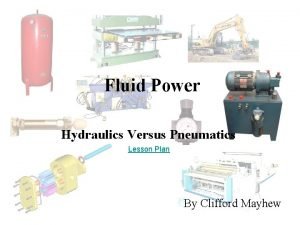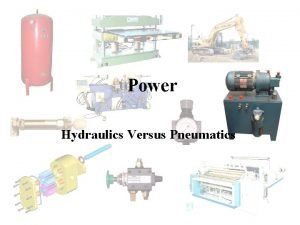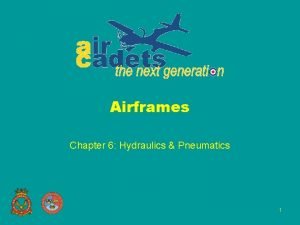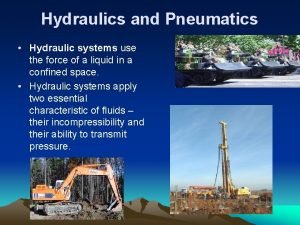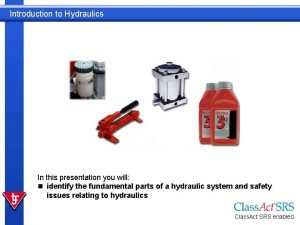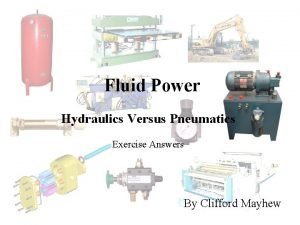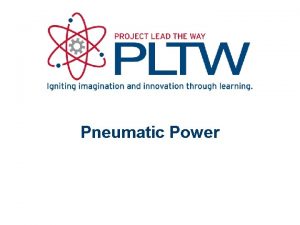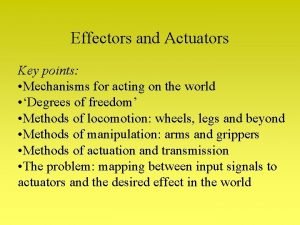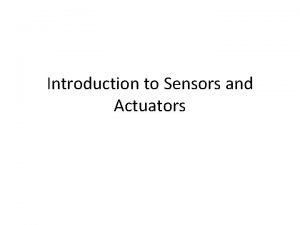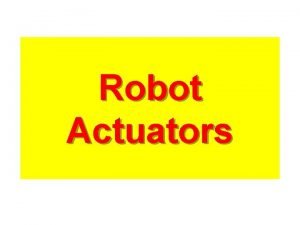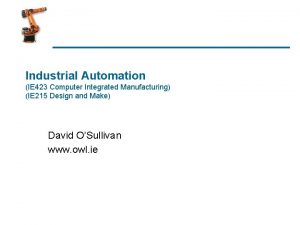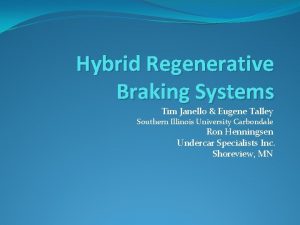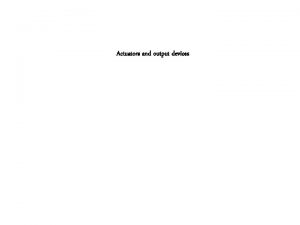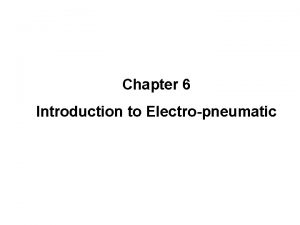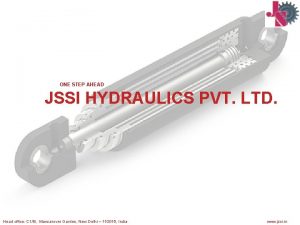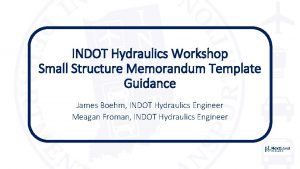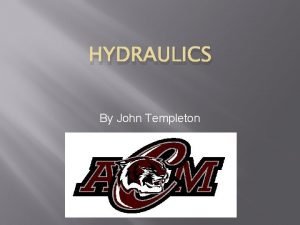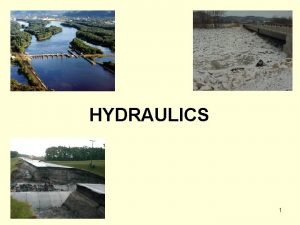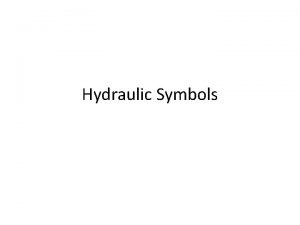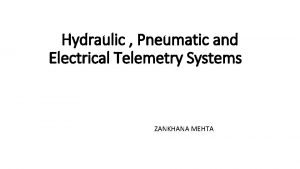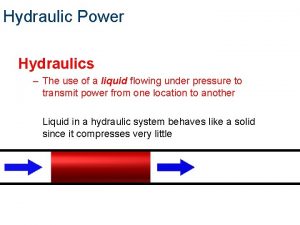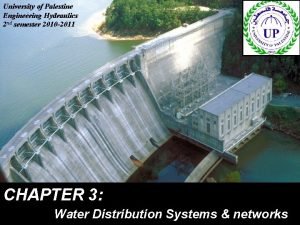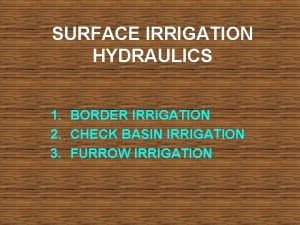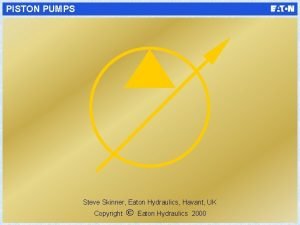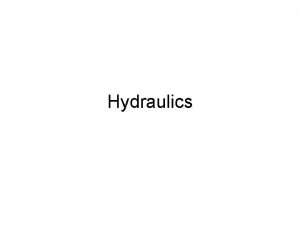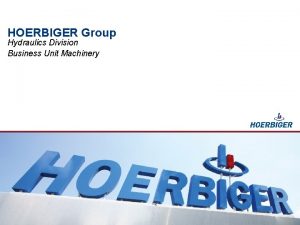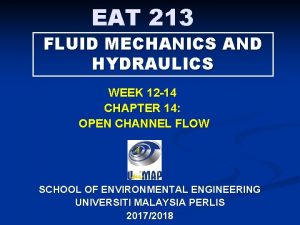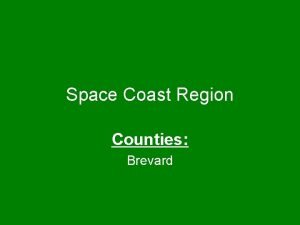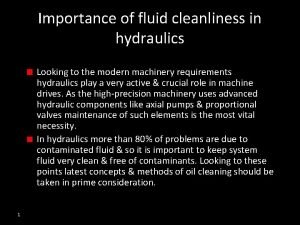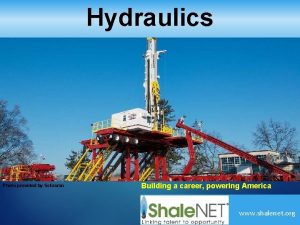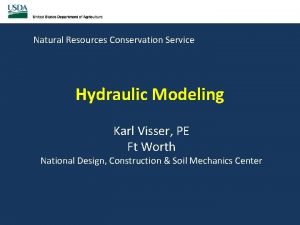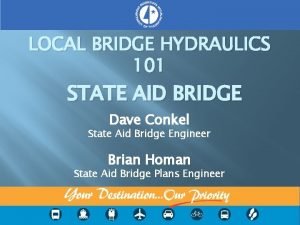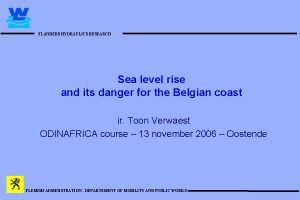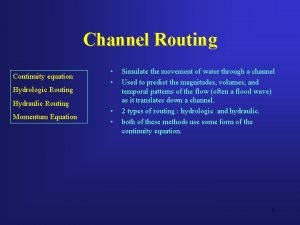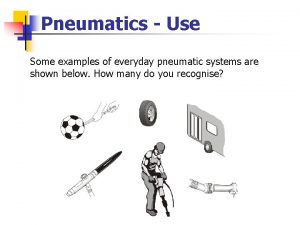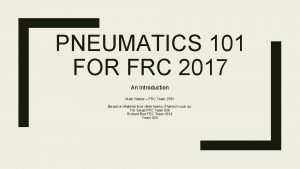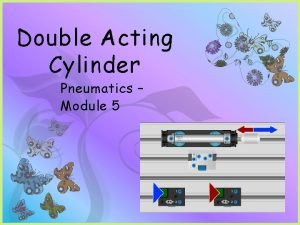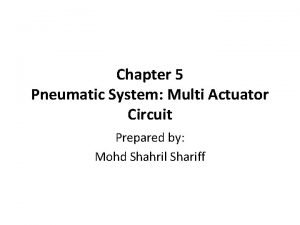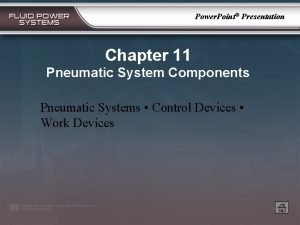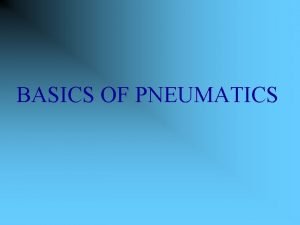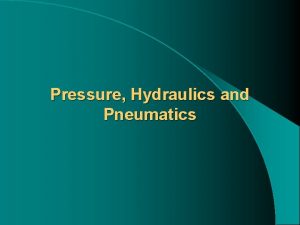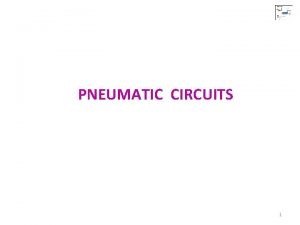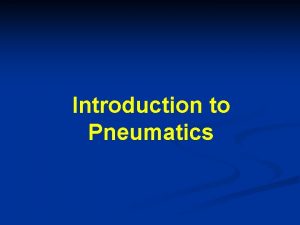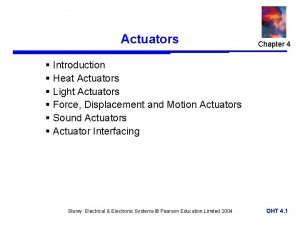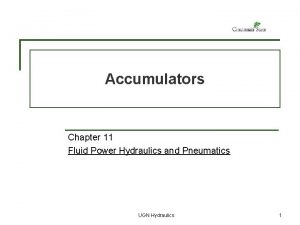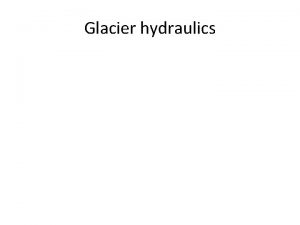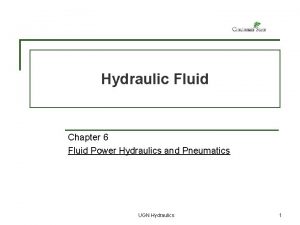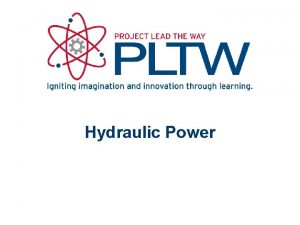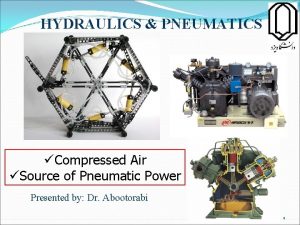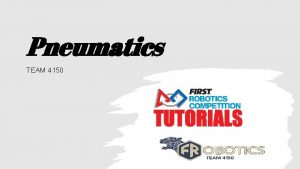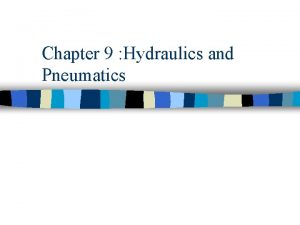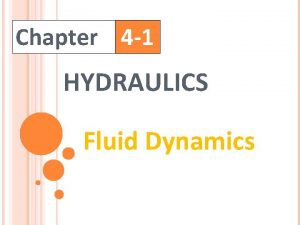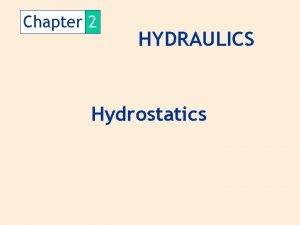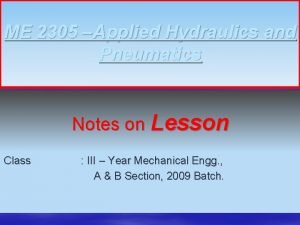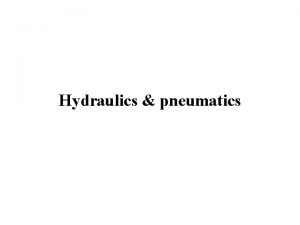Actuators Chapter 9 Fluid Power Hydraulics and Pneumatics























































- Slides: 55

Actuators Chapter 9 Fluid Power Hydraulics and Pneumatics UGN Hydraulics 1

Hydraulic Cylinders n n n Convert fluid pressure and flow into linear mechanical force and movement Often called linear actuators Controlling system pressure and flow rates allows a wide range of cylinder forces and speeds UGN Hydraulics 2

Basic Cylinder n n n Consists of a movable element made up of a piston and piston rod assembly Seals are incorporated to prevent fluid leakage around the piston Basic parts include: q q Barrel Head and cap Piston and rod Seals and rod wipers UGN Hydraulics 3

Barrel n n n Tube portion of a cylinder Made from metal tubing Wall thickness and type of material are important factors q Provides adequate strength for safe axial operation UGN Hydraulics 4

Head and Cap n Head closes the barrel end through which the cylinder rod passes q n Cap closes the opposite end without the rod q n Often called the rod end Often called the blind end Seals at both ends of the cylinder to prevent fluid leakage UGN Hydraulics 5

Piston and Rod n Working parts of a cylinder n The piston separates the cylinder into two, variable-size chambers n The rod is connected to the piston and transfers generated force to act against the load UGN Hydraulics 6

Seals and Rod Wipers n n Seals prevent internal and external fluid leakage Static seals are materials compressed between two rigid, nonmoving parts Dynamic seals function between parts moving relative to one another Wiper seals prevent contaminants from entering the barrel during rod retraction UGN Hydraulics 7

Classification of Cylinders n Variety of cylinders available for fluid power systems n Operating principles and construction are type two common classification methods UGN Hydraulics 8

Operating Principles n Single-acting cylinders exert hydraulic force only on rod extension or retraction q n Rod movement in the opposite direction requires an outside force (usually a spring) Double-acting cylinders exert hydraulic force on both rod extension and retraction q q Force exerted is different between extension and retraction Directional control valve alternately directs fluid to opposite sides of the piston to control extension and retarction UGN Hydraulics 9

Construction Type n n Relates to the method used to attach cylinder head and cap to barrel Tie-rod cylinders attach pieces to barrel with external rods q Common in heavy industrial equipment UGN Hydraulics 10

Construction Type n Mill cylinders attach pieces to flanges welded on barrel ends q Originally developed for applications in heavy industries like steel mills UGN Hydraulics 11

Construction Type n Threaded-end cylinders attach pieces to the barrel using machine threads q Relatively light in weight, compact, and easy to keep clean UGN Hydraulics 12

Construction Type n One-piece cylinders have pieces permanently attached to the barrel q q Considered a throwaway item due to unserviceability Cost effective for circuits that do not require continuous operation UGN Hydraulics 13

Other Cylinder Forms n Double-rod-end cylinders have a rod attached to both faces of piston q q The speed same for extension and retraction A disadvantage is an overall increase in cylinder length UGN Hydraulics 14

Other Cylinder Forms n Rams are single-acting with rod same diameter as bore of barrel q n Hand-operated hydraulic jack Telescoping cylinders are constructed of several nested barrel/rod combinations q For applications requiring long extension distances UGN Hydraulics 15

Cylinder Cushioning n Cushioning is used to control the approach of the rod to cap or head at stroke completion q n Prevents damage from direct impact Consists of plunger cavities, check valves, and adjustable orifices UGN Hydraulics 16

Cylinder Mounting n Fixed-centerline mount q q q Aligns centerline of cylinder with forces created by system load Strong, but cannot tolerate misalignment Tie rod, head-end flange, and cap-end flange variations UGN Hydraulics 17

Cylinder Mounting n Fixed-noncenterline mount q q q Attached to equipment by feet connected to head and cap ends Feet not at centerline Cylinders must be carefully sized or a rotating force can cause stress to parts UGN Hydraulics 18

Cylinder Mounting n Pivoting-centerline mount q q Allows cylinder to pivot to follow arc movement Clevis mount and trunnion mount UGN Hydraulics 19

Cylinder Calculations n The force a cylinder can generate depends on system pressure and effective piston area q The effective piston area is the surface area of the piston exposed to system pressure UGN Hydraulics 20

Cylinder Calculations n The speed a cylinder extends or retracts depends on fluid volume displaced per inch of piston travel and amount of fluid entering cylinder UGN Hydraulics 21

Typical Cylinder Specifications n n n Duty service Construction type Pressure rating Fluid rating Acceptable operating temperature Bore size Piston rod diameters Mounting styles Stroke Cushions Rod end configurations Ports UGN Hydraulics 22

Display of Cylinder Specifications Fig 9 -26 UGN Hydraulics 23

Limited-Rotation Hydraulic Actuators n Provides restricted rotary or reciprocating rotary motion for lifting/lowering, opening/closing, or indexing operations n Sometimes called torque motors UGN Hydraulics 24

Design and Construction n The rack-and-pinion design consists of rack gear and pinion gear powered by two concentric cylinders Load carrying capacity determined by the strength of the housing and load rating of the output-shaft bearings Operating efficiency is approximately 90% UGN Hydraulics 25

Design and Construction n The vane design consists of a barrel-shaped body, rotor, and two head pieces q n n Body contains a stationary barrier called the stator Single-vane and double-vane units Operating efficiency as high as 90% UGN Hydraulics 26

Design and Construction n n The helical piston-and-rod design consists of a cylindrical housing containing a sleeve piston and power output shaft The torque output depends on system pressure, piston area, and angle of helix machined into a rotating output shaft q n High torque output in relation to small size Average operating efficiency of 80% UGN Hydraulics 27

Applications of Limited-Rotation Actuators n Performs a multitude of functions in a variety of industries q q q Holds materials under tension in manufacturing Tilts electric furnaces for pours in steel industry Opens and closes hatches in marine industry UGN Hydraulics 28

Hydraulic Motors n n Often called rotary actuators Converts fluid pressure and flow into torque and rotational movement Can obtain a wide range of torque and rotational speeds by varying system pressure and flow Similar design as, but their function is different UGN Hydraulics 29

Conceptual Hydraulic Motor n n Consists of a housing, rotating internal parts, and power output shaft component groups The system fluid enters the housing and applies pressure to the rotating internal parts q The fluid moves the power output shaft and applies torque to rotate a load UGN Hydraulics 30

Conceptual Hydraulic Motor n The design of mechanical parts must incorporate four basic concepts: q q Equally spaced vanes Fluid moved through inlet port must contact surface of one rotor vane Sealed chambers between vanes Outlet port returns fluid to reservoir at near atmospheric pressure UGN Hydraulics 31

Four Basic Concepts for Motor Operation UGN Hydraulics 32

Displacement and Bearing Load Classification n Fixed-displacement motor q q n Variable-displacement motor q q n Internal geometry cannot be changed Same volume needed per output shaft revolution Internal geometry can be changed Operator can easily change motor speed Bearing load design as balanced or unbalanced UGN Hydraulics 33

External-Gear Motors n Simplest of the basic motor types n Fixed displacement and pressure unbalanced n Consists of a housing with cavities that allow fluid into and out of the unit UGN Hydraulics 34

External-Gear Motors n n Output shaft supported by bearings in housing Motor turns as long as force generated by system pressure overcomes internal motor resistance and shaft load UGN Hydraulics 35

Internal-Gear Motors n n Fixed displacement and pressure unbalanced Gearotor constructed of housing containing cavity fitted with three rotating elements The tips of external teeth always in contact with the surface of internal teeth Motor turns as long as system supplies fluid and pressure high enough to overcome internal motor resistance and system load UGN Hydraulics 36

Internal-Gear Motors n n An orbiting-gearotor motor is a variation of the basic gearotor design Gear with internal teeth is fixed Gear with external teeth rotates Rollers reduce internal motor friction q Increased operating efficiency and reduced wear UGN Hydraulics 37

Vane Motors n Most basic design q q n n n fixed-displacement pressure unbalanced Consists of housing, rotating internal parts, and power output shaft Output shaft, rotor, and vanes are located offcenter in the housing Fluid is forced into small chambers q Volume of chambers increases, turning the motor shaft UGN Hydraulics 38

Vane Motors n n Variable-displacement vane motors allow the operator to change motor speed without changing system flow rate Includes movable cam ring q n n Balanced-vane motors have fixed displacement and balanced load Cam ring with slightly oblong chamber opening q q n Moving ring center point in relation to rotor center point changes chamber sizes Two chambers each with inlet and outlet ports Inlet ports 180° apart, outlet ports 180° apart Ports opposite each other balances bearing loading UGN Hydraulics 39

Piston Motors n Available as both fixed and variable displacement units n Bearing loads are generally considered unbalanced n Pistons reciprocating in cylinders are the source of force required to rotate the power output shaft n Inline, bent-axis, and radial three most common designs UGN Hydraulics 40

Axial-Piston Motors n n n Inline design has pistons and cylinders exactly inline with power output shaft Swash plate converts linear force generated from pressure on pistons into torque required to turn motor Can have fixed or variable displacement UGN Hydraulics 41

Axial-Piston Motors n n Bent-axis design has pistons and cylinders that form an angle with power output shaft Universal joint connects power output shaft and cylinder barrel Angle between barrel and output shaft causes pistons to reciprocate as the motor turns Can have fixed or variable displacement UGN Hydraulics 42

Radial-Piston Motors n n Pistons and cylinders are perpendicular to centerline of power output shaft Two motor designs q n Rotating-cylinder-block and fixed-cylinder Can have fixed or variable displacement q Determined by reaction ring or eccentric UGN Hydraulics 43

Other Motor Designs n n Screw motors provide quiet, vibration-free operation Cam-type radial-piston motors are used in applications where equipment drive wheels are directly mounted on the power output shaft UGN Hydraulics 44

Series Connections of Motors n A series circuit has the inlet line of first motor connected to system pump q q n n Inlet lines of additional motors are connected to the outlet of preceding motor Outlet of last motor in series returns fluid to reservoir Total system pressure is divided in proportion to the load placed on each motor All motors operate at about same shaft speed if the motor displacements are equal UGN Hydraulics 45

Parallel Connections of Motors n n A parallel circuit has inlet lines of motors connected to a common supply line from pump Simple parallel circuit q The size of each motor and loads must be balanced to provide consistent operating speed UGN Hydraulics 46

Parallel Connections of Motors n Parallel circuit with flow control q Pressure-compensated flow control valves divide pump fluid output UGN Hydraulics 47

Braking Circuits n Braking circuits slow hydraulic motors with heavy rotating loads to a stop q q Inertia can continue to turn the motor shaft Braking occurs when fluid discharged from motor outlet port is forced to pass through adjustable pressure control valve before returning to reservoir UGN Hydraulics 48

Replenishment Circuits n n n Replace fluid lost through system leakage Used in systems that continuously circulate fluid through the motor and pump without returning it to large reservoir Works in conjunction with a braking system for bidirectional motor UGN Hydraulics 49

Hydrostatic Drives n n Uses a drive unit where a hydraulic pump provides fluid to drive a motor Not prime movers Depends on electric motor, internal combustion motor, or other device for hydraulic pump power Easily adjusts and control output shaft speed, torque, horsepower, and direction of rotation UGN Hydraulics 50

Hydrostatic Transmissions n Hydrostatic drives are considered hydrostatic transmissions when both the pump and motor have variable displacement q n Integral construction combines all transmission parts into single housing q n Manually or automatically adjusted to control torque, speed, and power Generally in lower-horsepower devices Nonintegral construction has the pump attached to the prime mover and the motor attached to workload q Hoses or tubing connect pump, motor, and accessories UGN Hydraulics 51

Conceptual Circuit Construction and Operation n Open-loop circuit uses layout of basic hydraulic motor circuit q q Motor is stopped or reversed by shifting directional control valve Speed depends on relationship between the displacement of the pump and displacement of the motor UGN Hydraulics 52

Conceptual Circuit Construction and Operation n Closed-loop circuit uses layout where pump outlet directly connected to motor inlet q q Small replenishment pump and reservoir make up any fluid loss Speed depends on the relationship between the displacement of the pump and displacement of the motor UGN Hydraulics 53

Pump-Motor Arrangements n Fixed-displacement pump and motor q n Fixed maximum horsepower, torque, and output shaft speed Fixed-displacement pump and variable-displacement motor q q q Fixed maximum horsepower fixed, variable torque and speed Output shaft rotation can reverse if the variable-displacement motor is reversible Lower efficiency due to requirement of a relief valve UGN Hydraulics 54

Pump-Motor Arrangements n Variable-displacement pump and fixed-displacement motor q q n Variable horsepower and speed, fixed torque Output shaft rotation can reverse if pump design allows flow to reverse Variable-displacement pump and motor q q Variable horsepower, torque, and output shaft speed and direction Wide selection of torque- and speed-to-power ratios UGN Hydraulics 55
 Fluid power hydraulics and pneumatics
Fluid power hydraulics and pneumatics Hydraulic vs pneumatic
Hydraulic vs pneumatic Hydraulic system advantages
Hydraulic system advantages Pneumatics and hydraulics basics
Pneumatics and hydraulics basics Introduction to hydraulics and pneumatics
Introduction to hydraulics and pneumatics Hydraulics and pneumatics quiz
Hydraulics and pneumatics quiz Pneumatics vs hydraulics
Pneumatics vs hydraulics Actuators and effectors
Actuators and effectors Ppt on mechatronics
Ppt on mechatronics Difference between sensors and actuators
Difference between sensors and actuators Advantages and disadvantages of hydraulic actuators
Advantages and disadvantages of hydraulic actuators Fixed automation diagram
Fixed automation diagram Transcellular fluid compartment
Transcellular fluid compartment Extracellular fluid and interstitial fluid
Extracellular fluid and interstitial fluid Agent peas
Agent peas Talley actuators
Talley actuators Actuator output device
Actuator output device Synovial membrane
Synovial membrane P1-p2
P1-p2 Fluid statics deals with fluid at rest
Fluid statics deals with fluid at rest Bioimpedância
Bioimpedância Interstitial vs intracellular
Interstitial vs intracellular Define fluid kinematics
Define fluid kinematics Shifting dullness vs fluid thrill
Shifting dullness vs fluid thrill Power traiangle
Power traiangle Solenoid symbol electrical
Solenoid symbol electrical Jssi hydraulics pvt. ltd
Jssi hydraulics pvt. ltd Indot design memo
Indot design memo Hydraulics definition
Hydraulics definition Hydraulics definition
Hydraulics definition Hydraulic flow meter symbol
Hydraulic flow meter symbol Pneumatic telemetry system
Pneumatic telemetry system Hydraulics
Hydraulics Palestine hydraulics
Palestine hydraulics Border irrigation definition
Border irrigation definition Eaton havant
Eaton havant Hydraulics
Hydraulics Hoerbiger benefits
Hoerbiger benefits Hydraulics
Hydraulics Space coast hydraulics
Space coast hydraulics Cleanliness in hydraulics
Cleanliness in hydraulics Professional hydraulics
Professional hydraulics Karl visser
Karl visser Hydraulics 101
Hydraulics 101 Khan academy color palette
Khan academy color palette Flanders hydraulics research
Flanders hydraulics research Continuity equation hydraulics
Continuity equation hydraulics Continuity equation hydraulics
Continuity equation hydraulics Pneumatic machines examples
Pneumatic machines examples Pneumatics frc
Pneumatics frc Difference between direct and indirect pneumatic circuit
Difference between direct and indirect pneumatic circuit Cascade method pneumatic circuit design
Cascade method pneumatic circuit design Pneumatic valves ppt
Pneumatic valves ppt Basics of pneumatics
Basics of pneumatics Hydraulic systems examples
Hydraulic systems examples Double acting cylinder pneumatic circuit
Double acting cylinder pneumatic circuit
